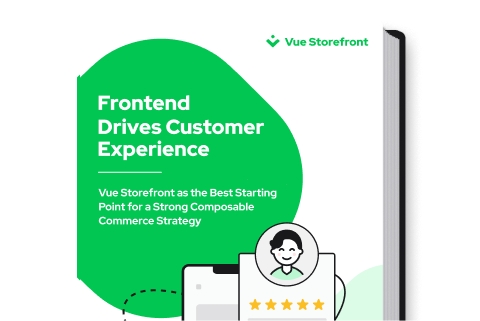Explore by Category:
Frontend
Headless Commerce Frontend: The Importance of It
Running eCommerce is becoming progressively a bigger effort. It is because of the rapid changes happening in the societal surrounding, the rise of competition, and the technology (both running an eCommerce and exposing results in search engines). To strive, compete or innovate brands need interactive, appealing and rival action at the well-performing headless frontend.
Here you will find the matter of eCommerce frontend , some differences between web and beyond-desktop retail frontend layer. Insights into the headless and headless frontend approach towards performance and customization, and its role in eCommerce. In the end, we expose some headless frontend implementation examples that fuel online storefronts.
What is an eCommerce frontend?
eCommerce frontend is the part of an online store that interacts with an online shopper. It’s the outcome of the data stored in the backend (products, prices, order details, customer information) and presented in an appealing way.
Hence it is often described as a client-side of eCommerce that engages the user with fonts, colors, image sliders, shopping carts, search bars, drop-down menus, product detail pages, extra videos, and occasionally advanced interactive features.
Learn more about what is an eCommerce storefront .
What is the role of the eCommerce frontend?
Any web design and this includes the eCommerce frontend, should be aligned with three fundamentals of any successful online creation, which is
- Design sphere – the visual, distinguishing side of brand’s identification and the first impression maker. The one that integrates and reveals the backend data in a thought-out and smart way – that’s the essence of a great web design.
- User Experience (UX) – a follow-up to the web design, carefully thought-out layer to interact and navigate the user through an online experience.
- Performance – the first 3-4 seconds of a page load are responsible for conversion rates. The longer it takes to access the site, the higher the bounce rate occurs. And this translates into lower search engine rankings and is accompanied by a lower customer satisfaction rate. In fact, nearly 50% of eCommerce users expect page load in less than two seconds.
All three are closely tied together and considered as deal makers or breakers. A well-optimized eCommerce frontend creates a first impression that navigates users through the next stages of the online shopping experience. It’s a blend of informative CTAs, a neat layout (web and mobile), and optimized web components.
What is a Headless Commerce Frontend?
A headless frontend is a responsive presentation layer that supervises and orchestrates the user-side of eCommerce. It gathers the data stored in the eCommerce backend and exposes it in an organized manner with a reduced page load on any device. A proper headless frontend can be described as a progressive tech ecosystem that binds together all of the headless components and assures the proper and efficient functioning of the digital storefront.
A headless frontend enables quick and smooth deploys. Frontend is all about creating and delivering a functional and engaging customer experience. When talking about headless commerce we have in mind a presentation layer or CX Layer (Customer Experience Layer) - which applies to the headless paradigm – decoupled backend and frontend. It is a modern approach, embedded in the technical side of eCommerce (and headless technology ) as a quick response to overcome a huge obstacle, which is an outdated legacy stack.
The resolution to monoliths lies in API and is headless
Keeping in line with all the updates becomes impossible since the legacy stack becomes a burden. eCommerce platforms that were designed to serve well a couple of years ago are too complex and too locked-in in their own dependencies. This results in limiting freedom of action at a more sophisticated level.
Below we elaborate a bit more on the headless naming and the confusion that aroused around it. If you’re ok with all the headless terminology, you can skip the part and jump into the next section – Headless Commerce frontends.
To overcome the limits developers came up with a responsive solution – which is headless and communicates via APIs. Although the headless approach seems to be a very agile and swift response to the eCommerce challenges, at the same time the headless terminology is very confusing for the non-tech world. Since we talk about head-less solution, why at the very beginning there was a head? What is the eCommerce head? What happened to the head in headless commerce and what replaced the head?
Starting from the beginning, monoliths - complex eCommerce platforms rose and (for a moment) shone. In a monolithic system the backend and frontend of all services are part of the same code base and communicate directly with each other. All parts are tightly coupled. Historically, here is the head, which was later metaphorically chopped off in a headless approach. And that head is a frontend, an integral part of complex eCommerce platforms.
The act of chopping off the head is decoupling the monolith system. In other words, separating the frontend from the backend. As a consequence, developers gain two independent modules that can communicate with each other independently without affecting the entire integrity.
When the initial monolithic head was chopped off, the term headless emerged and set a new approach to creating and running online commerce.
With the spread of headless, much buzz came to life. Headless-friendly CMSs have taken over the ideation of headless commerce, casting a shadow over the rest of the headless ecosystem.
When talking about headless commerce, one must be aware that it is all about the efficient composition of the tech stack that orchestrates in symbiosis with the business requirements. And naturally, a headless ecosystem needs a head – a frontend platform for headless commerce.
This should be enough to cover the overall headless naming issue with a very general understanding. You can also check the brief history of the time when everything we knew about the Internet changed .
Differences between eCommerce frontends and headless commerce frontends
The main difference between the monolithic legacy stack and the headless frontend is flexibility. Many vendors offer tightly combined systems that suggest an easy building of an online store. However, further adjustable functioning is restricted by a high level of dependency. A small change at the front of the traditional eCommerce platform becomes a tedious and time-consuming task for developers. The coupled and outdated frontend becomes a burden limiting the responsiveness of eCommerce businesses.
A headless frontend is designed to overcome the increasing limitations. The decay of system dependence and proper communication between components enables smooth functioning and agile implementations at the headless frontend.
With the flexibility provided by the headless frontend comes quicker time-to-market and as a follow-up, dynamic offerings. The business can address new expectations while developers can provide quick implementations at the visual side of the eCommerce, and the backend data remains unaffected.
With headless frontend comes best-of-breed, which is yet another often repeated phrase, that covers freedom of choice among technologies. Thanks to the API and flexible nature of the headless approach, adding 3rd party applications or integrating with new technologies becomes manageable. Headless frontends integrate new components together and provide numerous benefits for eCommerce businesses.
Importance of headless commerce frontend
Taking the headless direction means a change in overall eCommerce functioning – decoupling dependencies, and switching to more agile implementations. Gaining the flexibility and usability of the stack typically relies on three main components: the backend system, headless frontend and headless CMS , but it’s not limited to these parts.
The backend is the eCommerce platform, the engine that stores product, customer and order data and best headless commerce platforms can offer a wide range of capabilities – from ease of use like Shopify to pure headless operations granted by commercetools.
A pure headless CMS is also a backend system responsible for storing and delivering on-demand content to any device via API. When forming their own headless stack, eCommerce can choose between open-source headless CMSs or subscription-based solutions.
Headless frontend enables and secures proper functionality of the eCommerce storefront. It is a separate layer of the headless stack that interacts with the user. Headless storefronts link together data stored in the backend systems and expose flexible, eye-catching and user-friendly experiences via API.
Most headless frontends are PWA s – Progressive Web Applications. Based on best practice web technologies, PWA delivers a silky, swift, app-like experience to users. Headless frontends based on PWA allow brands to enhance UX with no changes to the backend.
Pure headless frontend solutions in the hands of developers become powerful tools for the agile development of unique user experiences and the creation of efficient purchase paths. Well orchestrated headless frontends drive performance at a higher level, provide best-in-class Server-Side-Rendering experience and transform lagging load times into fractions of a second.
A proper headless frontend reduces the burden previously caused by the complex nature of a monolithic platform. The technical side can implement changes quickly and the business side does not have to worry about a drop in search rankings or high bounce rate.
Benefits of a headless frontend
Gaining flexibility at the frontend of eCommerce brings numerous benefits that drive performance, satisfaction, and revenue.
- Web performance and mobile
A burning issue for all the merchants. Since online users browse on various devices, delivering a performant experience is a challenge. According to data provided by outerbox, 79% of smartphone users have made a purchase online using their mobile device in the last 6 months. With that revealed, mobile-first indexing becomes an integral part of any relevant eCommerce strategy. Headless frontend enables intuitive adaptation to any device accessing the store and ensures the most user-friendly and fast experience.
- Quicker and safer upgrades
Open for customization, headless frontends unlock creative capabilities on the business and the tech side. Thanks to the modular architecture the risk of putting down the entire system doesn’t exist. Hence, the frequent developments and adjustments at the front are not limited by the dependencies. Developers gain room for smart implementations and marketers lose the frustration caused by the conservative tactics limited by a standard layout.
- Advanced personalization
A follow-up to the upgrades. Instead of adjusting to the layout embedded in platform dependencies, eCommerce owners gain a set of components and an open path for their very own, custom creations. Integrating necessary 3rd party applications and delivering specific functionalities for business becomes a matter of own preferences.
- Flexibility
The one most frequently repeated phrase. But it is true. The best thing about headless commerce is that once enforced unlocks a different more modifiable approach to running an online store. Business owners are not locked into dependencies and off-the-shelf solutions provided by the vendor. One can leverage the tech stack and compose the most fitting solutions or add some tailor-made ones.
What to take into account when choosing a (headless) frontend?
A search for headless components may turn into an overwhelming task since new headless solutions spring up like mushrooms. Among headless platforms, CMSs, storefronts, and 3rd party services one must pair the tech stack, business objectives, and capabilities of the resources. So, what to take into account when choosing a headless frontend for your eCommerce?
- Flexible UX
To avoid jumping from one frontend to another alike and vendor locked-in headless frontend it is a good idea to scan the provider. As a transition to headless is to ease scaling, one should look for a headless frontend that will not become a blocker in the next six months. Adding extra features, customization options and partner relations should be a top consideration.
- Resources
Pure flexible headless frontends enable customization. Providing exceptional results requires good coding skills. Sophisticated headless solutions are designed to ease and drive developers’ experience. They replace tedious work with ready-made components and leave room for custom actions.
- Your tech stack
Verifying your frontend and backend communication capabilities is essential for the efficient work and success of your eCommerce. Composing a headless tech stack requires integration and coverage of the necessary features.
What is the best frontend for headless commerce?
There are several answers to this question. However, the best frontend for headless commerce is the one that best fits the overall business strategy. It should resonate with the technical requirements, and serve as an agile tool in the hands of developers. A frontend for headless commerce should also be backed by technology guidance from the vendor. When in search of headless zen keep an open eye on performance, scalability, customization options, and partnership relations.
What makes Alokai so unique on a headless market?
We crafted a whole ecosystem of tools that can work together, or independently. Each of them is addressing one of the challenges merchants face while building eCommerce storefronts. With Alokai dev tools any eCommerce can:
- Build and customize your store with design systems and UI library,
- Connect via our API orchestration eCommerce platforms, CMSs, Payment methods, search, and 3rd party applications,
- Accelerate actions at the front and drive performance, accessibility, and scalability with no fuzz about tech debt.
Check out great projects already benefiting from VSF's agile approach!
Share:
Share:
More in Frontend
Ready to dive in? Schedule a demo
Get a live, personalised demo with one of our awesome product specialists.






















